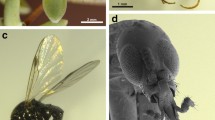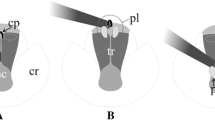Abstract
An investigation of pseudocopulation behaviour in species ofOphrys from southern Spain confirms the close relationship betweenCampsoscolia ciliata (Scoliidae) andOphrys speculum, and betweenEucera nigrilabris (Apoidea) andOphrys tenthredinifera. It could be demonstrated thatEucera barbiventris is the pollinator ofOphrys scolopax subsp.scolopax, whereas other species ofEucera andTetralonia which are active at the same time show no interest at all for the flowers of this species. Special attention was paid to the forms of the taxonomically confusedOphrys fusca group:O. fusca s. str.,O. iricolor, O. omegaifera andO. atlantica. WhileO. fusca s. str. is widespread, small-flowered and has late anthesis,O. iricolor has very large flowers and early anthesis. Each of the four members ofO. fusca agg. in S. Spain is pollinated by a different bee, and selective experiments show that each of these four species of bees is specifically attracted only to one of theOphrys species:Andrena flavipes is the pollinator ofO. fusca s. str.,Colletes cunicularius infuscatus ofO. iricolor, Anthophora atroalba ofO. omegaifera, andChalicodoma parietina ofO. atlantica. These four pollinators belong to 4 different bee families (Andrenidae, Colletidae, Anthophoridae, Megachilidae). As this type of pollination represents a very effective pregamic isolation mechanism, these four taxa ofOphrys fusca agg., at least in southern Spain, behave and should be regarded as genuine species.
Similar content being viewed by others
Literaturverzeichnis
Baumann, H., 1975: DieOphrys-Arten der SectionFusciluteae Nelson in Nordafrika. — Die Orchiedee26, 132–140.
Baumann, H., Halx, G., 1972:Ophrys — die Pflanze mit Sex. — Kosmos68 (2), 78–80.
Bodegom, J. van, 1971:Ophrys atlantica Munby in Spanje. — Orchideen33, 101–102.
Correvon, H., Pouyanne, M., 1916: Un curieux cas de mimétism chez les Ophrydéés. — J. Soc. Nat. Horticult. France17, 29–31; 41–42.
Danesch, O., Danesch, E., 1969: Orchideen Europas, Südeuropa. — Bern: Hallwag.
Danesch, O., Danesch, E., 1972: Orchideen Europas,Ophrys-Hybriden. — Bern: Hallwag.
Gajewski, W., 1959: Evolution in the genusGeum. — Evolution13, 378–388.
Godfery, M. J., 1925: The fertilization ofOphrys speculum, O. lutea andO. fusca. — J. Botany (London)63, 33–40.
Godfery, M. J., 1930: Further notes on the fertilization ofOphrys fusca andO. lutea. — J. Botany (London)68, 237–238.
Kullenberg, B., 1950: Investigations on the pollination ofOphrys species. — Oikos2(1), 1–19.
Kullenberg, B., 1961: Studies inOphrys pollination. — Zool. Bidr. Uppsala34, 1–340.
Kullenberg, B., 1973: New observations on the pollination ofOphrys. — Zoon, suppl.1, 9–14.
Kullenberg, B., 1977: Bestørning of artsdannelse hos Flueblomstslaegten (Ophrys). — Kaskelot (Hvalsø) 1977 (11), 6–9.
Kullenberg, B., Bergström, G., 1973: The pollination ofOphrys orchids. — In:Bend, G., Santesson, J., (Eds.): Chemistry in Botanical Classification. — Nobel Symp.25, 223–258.
Kullenberg, B., Bergström, G., 1976: Hymenoptera Aculeata males as pollinators ofOphrys orchids. — Zoologica Scripta (Stockholm)5, 13–23.
Nelson, E., 1962: Gestaltwandel und Artbildung, erörtert am Beispiel der Orchideen Europas und der Mittelmeerländer, insbesondere der GattungOphrys. — Chernex/Montreux.
Nieschalk, A., Nieschalk, C., 1978: Einige weitere Mitteilungen zur Kenntnis der Orchideenflora in Spanien. — Die Orchidee29, 78–80.
Paulus, H. F., 1978: Co-Evolution zwischen Blüten und ihren tierischen Bestäubern. — Sonderh. Naturwiss. Ver. Hamburg2, 51–81.
Paulus, H. F., Gack, C., 1980: Beobachtungen und Untersuchungen zur Bestäubungsbiologie südspanischerOphrys-Arten. — Die Orchidee, Sonderheft Nov., 55–68.
- -Ullrich, R., 1981: Beobachtungen und vorläufige Experimente zur Pseudokopulation vonEucera barbiventris mitOphrys scolopax. — (In Vorbereitung.)
Polunin, O., Smythies, B. E., 1973: Flowers of South-West Europe. — Oxford: University Press.
Pouyanne, M., 1917: La fécondation desOphrys par les insectes. — Bull. Soc. Hist. Nat. Afri. N.8, 6–7.
Soó, R. de, 1980:Ophrys. — Flora Europaea5, 344–349. — Cambridge etc.: University Press.
Sundermann, H., 1975: Europäische und mediterrane Orchideen. Eine Bestimmungsflora mit Berücksichtigung der Ökologie. — 2. Aufl. Hildesheim: Brücke Verlag.
Vogel, S., 1976: ZurOphrys-Bestäubung auf Kreta. — Jahresber. Naturwiss. Ver. Wuppertal29, 131–139.
Author information
Authors and Affiliations
Rights and permissions
About this article
Cite this article
Paulus, H.F., Gack, C. Neue Beobachtungen zur Bestäubung vonOphrys (Orchidaceae) in Südspanien, mit besonderer Berücksichtigung des FormenkreisesOphrys fusca agg.. Pl Syst Evol 137, 241–258 (1981). https://doi.org/10.1007/BF00982789
Received:
Issue Date:
DOI: https://doi.org/10.1007/BF00982789




